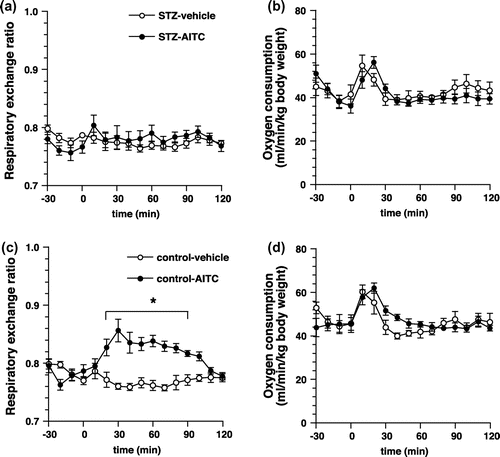Figures & data
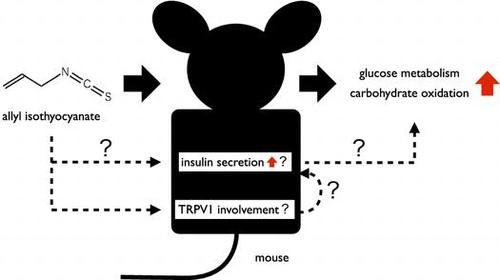
Figure 1. Changes in blood insulin levels of wild type mice. (a) Changes in blood insulin levels of mice administered with AITC or vehicle (control). Values are expressed as means ± SE. n = 4; *p < 0.05 (two-way repeated-measures ANOVA, followed by Bonferroni’s post hoc test). (b) Area under the curve of blood insulin levels of mice administered with AITC or vehicle. Values are expressed as means ± SE. n = 4; *p < 0.05 (unpaired t test).
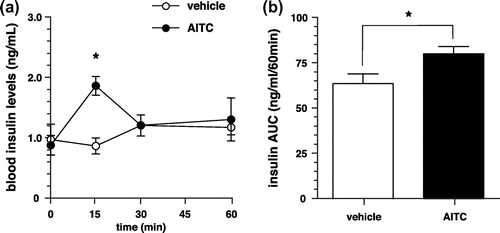
Figure 2. Changes in blood insulin levels of TRPA1 KO or TRPV1 KO mice. (a) Changes in blood insulin levels of TRPA1 KO mice administered with AITC or vehicle (control). Values are expressed as means ± SE. n = 5; *p < 0.05 (two-way repeated-measures ANOVA, followed by Bonferroni’s post hoc test). (b) Changes in blood insulin levels of TRPV1 KO mice administered with AITC or vehicle (control). Values are expressed as means ± SE. n = 7. There is no significant difference between the groups.
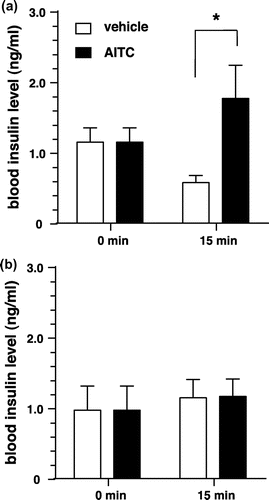
Figure 3. Insulin secretion and residual insulin content of isolated islets by AITC. (a) and (b) Effects of AITC on insulin secretion and residual insulin content of isolated islets from WT mice. Groups of islets were stimulated with 8.0 mM glucose buffer including AITC (0 or 20 nM) for 2 h. Released insulin into the buffer (a) and remained insulin in the islets (b) were measured. Values are expressed as means ± SE. n = 7–12. *p < 0.05 (unpaired t test). (c) and (d) Effects of AITC on insulin secretion and residual insulin content of isolated islets from TRPV1 KO mice. Values are expressed as means ± SE. n = 10–12. There is no significant difference between the groups.
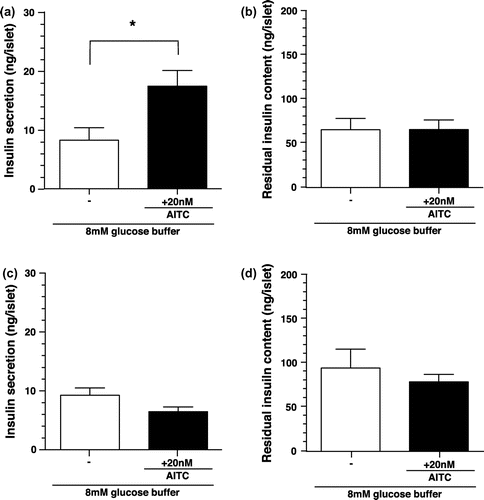
Figure 4. Effects of NAC-AITC for isolated islets on insulin secretion and residual insulin content in islets. (a) and (b) Effects of NAC-AITC on insulin secretion and residual insulin content of isolated islets from WT mice. Groups of islets were stimulated with 8.0 mM glucose buffer including NAC-AITC (0, 2 or 20 nM) for 2 h. Released insulin into the buffer (a) and remained insulin in the islets (b) were measured. Values are expressed as means ± SE. n = 18–19. *p < 0.05 (unpaired t test). (c) and (d) Effects of NAC-AITC on insulin secretion and residual insulin content of isolated islets from TRPV1 KO mice. Values are expressed as means ± SE. n = 10–11. *p < 0.05 (unpaired t test).
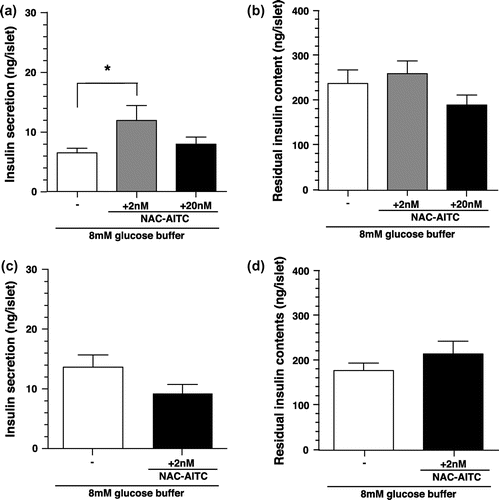
Figure 5. Respiratory gas analysis with insulin administered mice. (a) Changes in the respiratory exchange ratio of mice administered with insulin or saline (control). Values are expressed as means ± SEM. n = 12 (saline vs. insulin 0.5 IU/kg: p < 0.05 at 20–30 min; saline vs. insulin 1.0 IU/kg: p < 0.05 at 20–100 min; two-way repeated-measures ANOVA, followed by Bonferroni’s post hoc test). (b) Changes in oxygen consumption of mice administered with insulin or saline (control). Values are expressed as means ± SEM (n = 12). (c) Changes in carbohydrate oxidation of mice administered with insulin or saline (control). Values are expressed as means ± SEM. n = 12 (saline vs. insulin 0.5 IU/kg: p < 0.05 at 20–30 min; saline vs. insulin 1.0 IU/kg: p < 0.05 at 20–80 min; two-way repeated-measures ANOVA, followed by Bonferroni’s post hoc test). (d) Changes in fat oxidation of mice administered with insulin or saline (control). Values are expressed as means ± SEM. n = 12 (saline vs. insulin 0.5 IU/kg: p < 0.05 at 20–30 min; saline vs. insulin 1.0 IU/kg: p < 0.05 at 20–110 min; two-way repeated-measures ANOVA, followed by Bonferroni’s post hoc test).
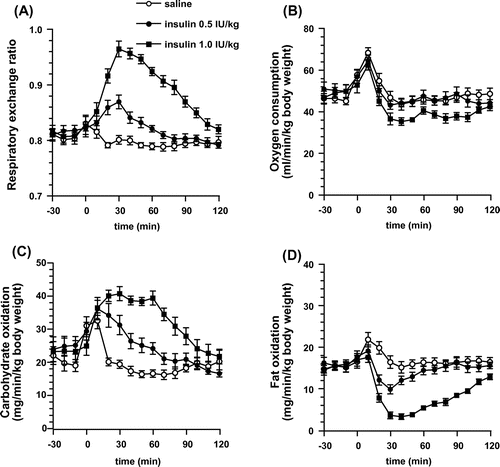
Figure 6. Changes in respiratory gas with insulin administered mice. (a) Average the respiratory exchange ratio of mice for 2 h after intraperitoneal administration of insulin or saline (control). (b)–(d) Cumulative oxygen consumption, carbohydrate oxidation, and fat oxidation of mice for 2 h after intraperitoneal administration of insulin or saline (control). Values are expressed as means ± SEM. n = 12; *p < 0.05 (Tukey’s test).
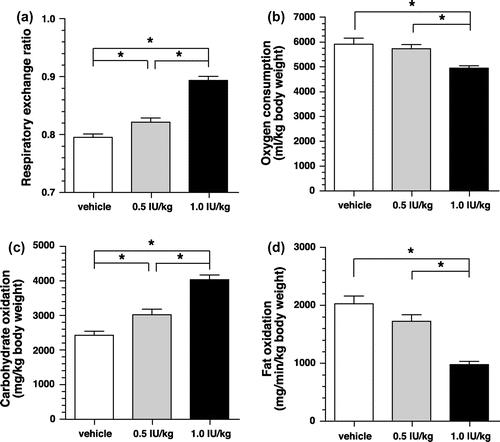
Figure 7. Respiratory gas analysis with glibenclamide administered mice. (a) Changes in the respiratory exchange ratio of mice administered with glibenclamide or DMSO (control). Values are expressed as means ± SEM. n = 9–10 (DMSO vs. glibenclamide 10 mg/kg: p < 0.05 at 40–70 min; DMSO vs. glibenclamide 30 mg/kg: p < 0.05 at 30–80 min; two-way repeated-measures ANOVA, followed by Bonferroni’s post hoc test). (b) Changes in oxygen consumption of mice administered with glibenclamide or DMSO (control). Values are expressed as means ± SEM (n = 9–10). (c) Changes in carbohydrate oxidation of mice administered with glibenclamide or DMSO (control). Values are expressed as means ± SEM. n = 9–10 (DMSO vs. glibenclamide 10 mg/kg: p < 0.05 at 30–40, 60 min; DMSO vs. glibenclamide 30 mg/kg: p < 0.05 at 40–60 min; two-way repeated-measures ANOVA, followed by Bonferroni’s post hoc test). (d) Changes in fat oxidation of mice administered with glibenclamide or DMSO (control). Values are expressed as means ± SEM. n = 9–10 (DMSO vs. glibenclamide 10 mg/kg: p < 0.05 at 50–60 min; DMSO vs. glibenclamide 30 mg/kg: p < 0.05 at 40–80 min; two-way repeated-measures ANOVA, followed by Bonferroni’s post hoc test).
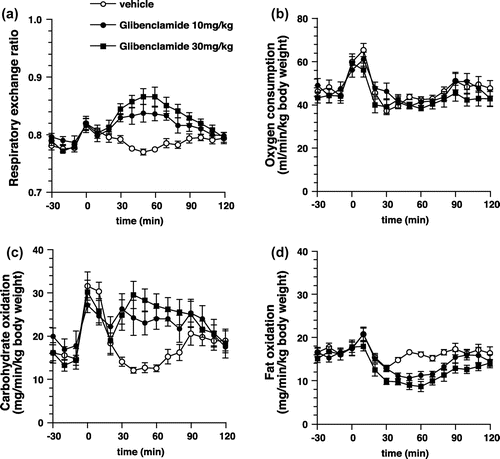
Figure 8. Respiratory gas analysis with STZ-treated mice. (a) and (b) Changes in the respiratory exchange ratio and oxygen consumption of STZ-treated mice administered with AITC (25 mg/kg) or vehicle (control). Values are expressed as means ± SEM (n = 9–10). (c) and (d) Changes in the respiratory exchange ratio and oxygen consumption of sham-treated mice administered with AITC (25 mg/kg) or vehicle (control). Values are expressed as means ± SEM (n = 7–10). *p < 0.05 (two-way repeated-measures ANOVA, followed by Bonferroni’s post hoc test).
